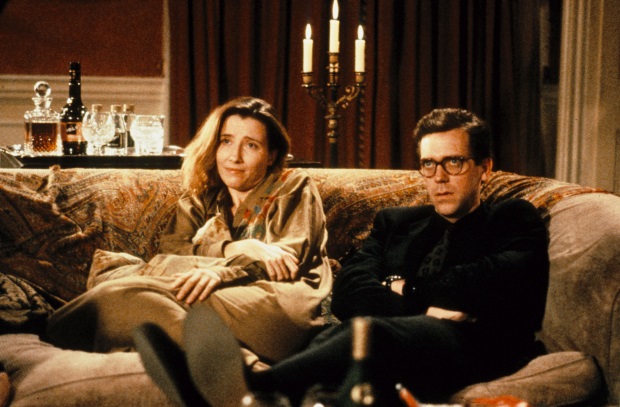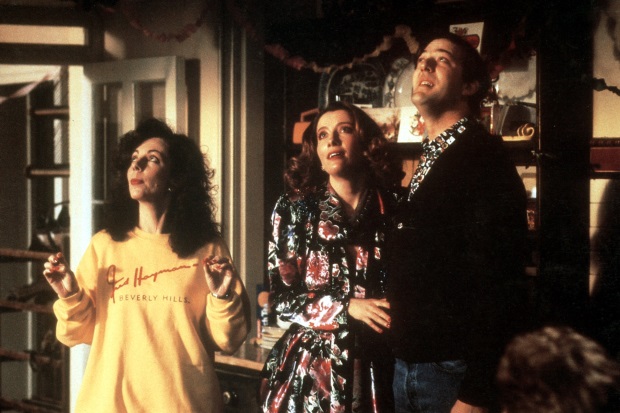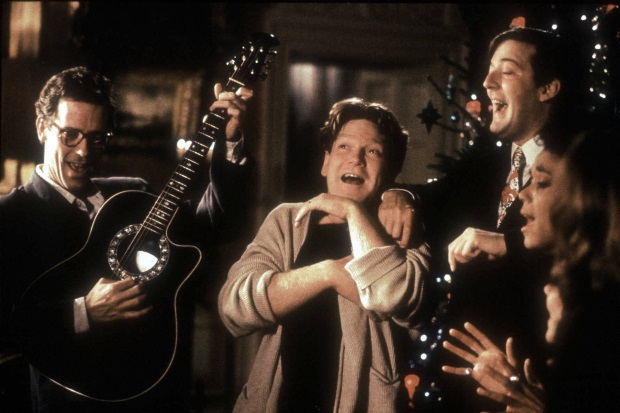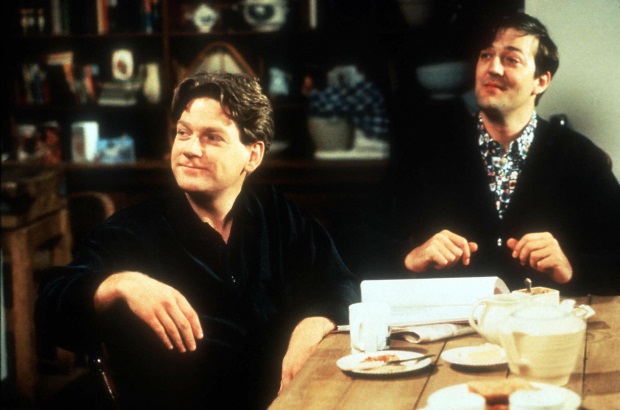Revisiting Peter’s Friends
Kenneth Branagh's third film as director was ensemble comedy Peter's Friends. We take a look back as the film passes its 25th birthday...
This article comes from Den of Geek UK.
In 1996, Kenneth Branagh penned and directed a film that felt – and I mean this as no criticism – tailor-made for his friends. The movie was the excellent and hugely underseen comedy In The Bleak Midwinter (known as A Midwinter’s Tale in the US), which for my money gave the late, great Richard Briers his very best screen role.
Yet I’d also argue that it was the second time he’d tackled such a project. First time around was his third film as director, a deliberate change of tack that demonstrated his versatility for the first of many times: Peter’s Friends.
Peter’s Friends, released for the first time in 1992, was called many things. It was The Big Chill for the UK. It was an excuse for a bunch of luvvies to get together on screen. It was a recharge-his-batteries project following his first American movie. But even rewatching it now, I think it’s another underappreciated movie in the Kenneth Branagh back catalogue. And heck, I’ve still got Dead Again to talk about in another article.
Still, the first many of us knew of Peter’s Friends was its trailer (although this was pre-world wide web times). The film was quietly and relatively swiftly put together by Branagh, on a modest budget. And the UK trailer, accompanied by Queen’s You’re My Best Friend, sold us a broad, funny-looking comedy.
Turned out, though, that there was a good deal more to Peter’s Friends than that.
Early days

The origin of the film wasn’t Branagh in this case (as it would be with the aforementioned In The Bleak Midwinter). Rather, the screenplay came to him from Rita Rudner and Martin Bergman. The then-married couple came up with draft one reportedly in under a week, and – with eventual backing from The Samuel Goldwyn Company and Channel Four Films – the movie was picked up not long thereafter. Rudner and Bergman had originally envisaged the project as an American movie, with an American ensemble. Branagh, though, signed up in 1991, and wanted the story relocated to Britain. He got his wish, and the script was reworked.
Branagh subsequently recruited a cast that reflected his regular company at the time (indeed, many of those involved would move onto his next project, Much Ado About Nothing, the year after). Thus, Emma Thompson, Hugh Laurie, Imelda Staunton, Stephen Fry and Tony Slattery joined Rudner, Branagh and Phyllida Law in the ensemble. Laurie and Fry reportedly were a little reluctant to join, feeling the casting of real-life old university friends playing, well, university friends, would paint a target on them that critics would gleefully aim at. Branagh proved persuasive, however, and he got his cast. Fry and Laurie’s cautions were proved accurate when the film was ultimately released.
Still, I’m getting ahead of myself. It helped, I’d imagine, in recruiting the cast that the movie didn’t take long to physically make at all. The shoot of Dead Again had taken place in Hollywood (next to the stage that The Hunt For Red October was filming on), and Branagh seemed keener to go lean following his time in the States. In all, the movie – which is pretty much contained to one location – was in the can in under two weeks. That includes the tricky, ambitious opening four minute shot that leads to the photograph of the younger version of the characters.
The basics

Peter’s Friends, then, works on a simple concept. It opens with a bunch of university friends performing, for the final time, their comedy review, in front of an unappreciative audience who happen to have given them £500 for the privilege. It’s an excuse for fun, frolics and dressing up in skimpy grundies, and saying goodbye to student days. One fairly harsh 80s montage and run through of Tears For Fears’ Everybody Wants To Rule The World later, we’ve moved from December 31st 1982 to December 31st 1992, and the film begins in earnest.
The scene is quickly set. Stephen Fry is Peter, and he’s just inherited a very large house, in which he’s hosting a big reunion party for his old friends. The core of six friends now come with extended family too, and it’s an awful lot of fun meeting them all then. Branagh rarely gets enough credit for how well his productions tend to introduce their characters. I can’t help thinking of the space he affords the key cast of In The Bleak Midwinter again, and the traits he quickly establishes.
Branagh plays a successful writer in an unhappy marriage with Rudner’s character, an actress and start of a hit US TV show. Then there’s Tony Slattery as Brian, the boyfriend of Alphonsia Emmanuel’s Sarah. Then there’s the couple who quietly steal the film: Staunton and Laurie, married, and wary of leaving their child behind for the weekend. All the clues, in fairness, are there for what gets revealed later – those The Big Chill parallels are very fair – but Branagh knows that this is a character piece, and that’s where his focus remains.
“An ensemble comedy about celebrating friendship”, is how he described the film in interviews around the time of its release, noting how the 80s and its inherent obsessions were touchpoints for the film.
Indoors

The structure of Peter’s Friends is clear quickly enough, and there is an argument that it could work equally well on the stage as it does on the screen. There may be something to that, not least because the bulk of the movie takes place indoors. But Branagh – coming to this after Henry V and Dead Again (and the short film Swan Song, for which he earned an Oscar nomination) – is clearly growing in different directions as a director here. I love, in films such as Much Ado About Nothing and Mary Shelley’s Frankenstein, through to his blockbusters such as Cinderella and Thor, how Branagh likes to sweep the camera across his sets, to keep things moving, and to explore his sets and locations. Just look at how he snakes the camera even through the carriage of the Orient Express in his most recent venture.
Here, I’d suggest is screen directing is at its rawest and most instinctive. That there’s a sense of experimentation, of relaxing a little, and just having a little more fun. I think it was John Grisham who, in the foreword to a later edition of his first novel, A Time To Kill, acknowledged that his book contained rawness and things he’d change if he were writing it now. Yet conversely, he wouldn’t change a word of the text now. I wonder if Branagh feels the same way about this one.
Peter’s Friends, for instance, comes with a soundtrack bursting with popular mainstream tunes (Queen’s aforementioned track at the forefront), and they don’t always easily flow with what’s happening on screen (in terms of using popular music as the backdrop of a film, I can’t help but evoke 2014’s Pride, where the jukebox felt surgically woven to the story the film was telling). But then it does add to the flavour of a bunch of friends telling stories, reminiscing and playing tunes. The soundtrack, and pace, keeps the film moving, even at times if it feels the proverbial track is a little bumpy.
I’d also suggest that this is the film where it became very apparent at just how excellent a director of comedy Kenneth Branagh is.
Maybe it’s his theatre background here, but his sense of timing when it comes to screen humour is often exquisite. Take a look at Thor for example of that. I like the first Thor movie a lot, and it’s only in the last third – when it gets more CG heavy and conventional – did I feel it really struggled. But the comedy beats are terrific, with moments well staged and barely a wasted comedy line. Even rewatching Peter’s Friends I found myself laughing a lot, with Stephen Fry’s precise delivery of the line “that’s what I call an extremely long dick” the crowning comedy moment.

Still, as many Branagh movies do, Peter’s Friends frontloads the comedy. It’s an effective tactic, as humour is used to set the characters and their relationships up, and then the layers are pulled back. Inevitably, as the underlying relationships and difficulties of the characters are revealed, things get darker, and little is done to dilute those The Big Chill comparisons as the film heads into its final act.
And yet it’s still its own thing. So keen were some to line up and take shots at people when the film came out, that much about it never got sufficient credit. For it’s a warts-and-all film, this, that isn’t the cleanest and most joined-up of Branagh’s movies, but packs one hell of a wallop. And I do think Imelda Staunton in particular is quite sensational here, as Imelda Staunton tends to be. In fact, I think the work of Fry, Laurie, Emma Thompson and Rita Rudner too is really something. I didn’t dislike a performance in the movie, to be clear, just that there’s some really wonderful work in here that I specifically wanted to cite.
Reaction
Sold as a heavy comedy and a jape-filled night at the flicks in the UK at least, perhaps it was inevitable that some would take against Peter’s Friends on that basis. I remember a few years later a film called This Year’s Love – a dark, impressive drama – was sold as a Valentine’s comedy in the UK and earned unjust backlash as a consequence. I don’t think Peter’s Friends got it that badly, but there was certainly a confluence of factors, not least the desire from some to use their pens to take the cast and director down a peg or two.
And the truth is that there are things wrong with Peter’s Friends. It doesn’t quite always flow. It bumps around a bit. The residual question lies as to whether it would work best as a play, and does it ever fully escape the feeling of a piece of theatre.
But I still like it. And I still admire too that at a point when British comedies were struggling to get screen space in UK cinemas – in 1992, it was period dramas and Oscar fare, and that was your lot if you were from Britain – that a punt was taken on Peter’s Friends. It still suffers from a terrible quality DVD release (it’s not even widescreen!), and it’s rarely brought up in interviews with those behind it. And I find that a pity. Because it was a rare British commercial hit in cinemas when it came out, it has interesting stuff in it, and it’s a film that deserves another look.
And in a double bill with In The Bleak Midwinter? It’d be perfect, thank you very much…